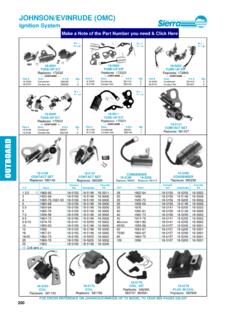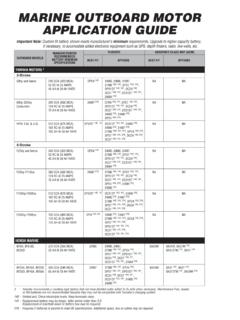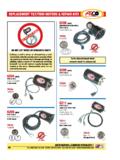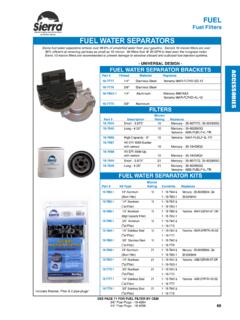Transcription of completely before you begin installation! - Marine …
1 Marine IGNITION. SAFETY SHUT-OFF SWITCH. GENERAL INFORMATION. This safety switch is designed solely to stop the engine of an inboard, I/O or outboard powered boat instantly in the event an operator is accidentally removed from the controls. This safety switch is not to be used on a jet ski, personal watercraft, or any other powered vehicle or vessel. The safety switch includes a lanyard fork which holds a plunger of the switch in position to allow engine operation. A lanyard extends from the fork and is connected to the operator. Should the operator move away from the controls, the fork is pulled free, releasing the plunger and stopping the engine. Read instructions completely before you begin installation ! installation INSTRUCTIONS.
2 I. MOUNTING INSTRUCTIONS. 1. Select a suitable mounting location on a panel or within an enclosed area near the operator controls. CAUTION: This switch does not comply to Coast Guard Standards or SAE 1171 for use or exposure in explosive environments. Do not mount this switch in an engine compartment. The location should: Provide protection from direct water splash, Allow for unrestricted lanyard movement, as shown in Figure 1. This is important, you must allow a 3 diameter circle around the switch for lanyard movement. Be certain the lanyard does not get caught on adjacent controls! Allow for proper orientation of the switch as shown in Figure 2. (Do not mount switch with the plunger axis below the horizontal.)
3 2. before drilling, check behind the panel for sufficient clearance around wires, pipes, control cables and other obstructions. 3. Measure the panel thickness and select the correct mounting arrangement, as shown in Figure3. 4. Drill a 9/16 inch hole in the panel, as shown in Figure 4 and with a file, enlarge the top and bottom portions of the hole. Note, the hole has an oblong shape to provide proper drainage and to prevent switch rotation. Do not overly enlarge the hole as rotation of the switch will prevent proper switch operation. 5. Assemble the back-up nut on the switch body if required, insert through the hole from the back (note correct location of UP marking as shown in Figure 3) and install face nut.
4 Hand tighten face nut until it bottoms on bushing. 6. Tighten the back-up nut, maximum 8 inch-lbs, to secure the switch. CAUTION: Do not overtighten as this may cause stripping of the switch threads. 7. Check for proper mounting security by removing the lanyard assembly with a brisk tug on the cord. Re-tighten back-up nut if switch is loose. WARNING: Mounting the switch plunger below horizontal and/or placing the drain holes other than as shown in Figure 3 will result in premature failure of the safety switch. II. ELECTRICAL CONNECTIONS FOR I/O OR INBOARD USE ONLY. 1. Disconnect all batteries and any auxiliary on-board or dockside power supplies. 2. Locate the purple ignition switch-to-coil wire, Diagram A. CAUTION: Be sure this wire goes directly to the coil and not to the instrument or alternator circuit.
5 Selecting the incorrect wire will result in improper switch operation which could lead to serious injury. 3. Cut the wire, strip the ends and install the two (2) crimp-on 1/4 inch female disconnect terminals provided. A crimping tool designed for insulated terminals must be used. 4. Attach the female disconnects to each of the NORMALLY CLOSED ( WITH FORK. INSTALLED) terminals, shown in Figure 5. 5. Recheck all connections. Install lanyard assembly, with the fork seated over the plunger. 6. Reconnect battery. 7. Start engine. If engine does not start: Disconnect battery, Recheck all electrical connections, Reconnect battery, and Restart engine. 8. Remove lanyard assembly. Engine should stop immediately. CAUTION: If engine fails to stop recheck all wiring.
6 Should the engine fail to start or stop, or resumes running with the lanyard fork removed, consult your local Marine dealer for assistance. III. ELECTRICAL CONNECTIONS FOR OUTBOARD USE ONLY. CAUTION: This safety switch is designed for use with outboard motors equipped with grounding type emergency stop circuits ONLY! If the following information is not correct for your model motor or application, consult with your local Marine dealer for details. 1. Disconnect all batteries and any auxiliary on-board or dockside power supplies. 2. Remove engine cover. 3. Locate the correct color emergency stop wire for your motor , referencing the table below. WIRE COLOR TABLE FOR LATE MODEL outboards . MANUFACTURER COLOR. Mariner Black with Yellow Stripe Mercury Black with Yellow Stripe Yamaha Black with Yellow Stripe Force Solid White Nissan Solid Brown Daihatsu Solid Brown Suzuki Solid Brown OMC Black with Yellow Stripe before 1965, Solid Blue Evinrude Black with Yellow Stripe before 1969, Solid Blue Johnson Black with Yellow Stripe before 1969, Solid Blue US Marine Blue with Black Stripe or Solid Blue 4.
7 Measure and cut two lengths of black 14 AWG Marine quality wire of sufficient length to connect one safety switch terminal to the emergency stop wire and the other terminal to a system ground, as shown in Diagram B. 5. Strip one end of each wire and crimp on the 1/4 inch female disconnect terminal provided. A. crimping tool designed for insulated terminals must be used. 6. Attach the female disconnects to each of the NORMALLY OPEN ( WITH FORK. INSTALLED) terminals, shown in Figure 5. 7. Attach the other end of one wire to the emergency stop wire, using a suitable insulated wire connecting device, reference Wire Color Table and Diagram B. 8. Attach the other end of the second wire to the ground point, using a suitable insulated wire connection device as shown in Diagram B.
8 9. Recheck all connections. Install the lanyard assembly with the fork seated over the plunger. 10. Replace engine cover. 11. Reconnect battery. 12. Start engine. If engine does not start: Disconnect battery, Remove engine cover, Recheck all electrical connections, Replace engine cover, Reconnect battery, and Restart engine. 13. Remove lanyard assembly. Engine should stop immediately. CAUTION: If engine fails to stop recheck all wiring. Should the engine fail to start or stop, or resumes running with the lanyard fork removed, consult your local Marine dealer for assistance. installation NOTES. ALL WIRING, CONNECTIONS AND TERMINATIONS should be done in accordance with ABYC. spec. E-3-73 and E-9-81. Recommended 1/4 female terminals: General P/N 01500 or equivalent.
9 Use 14 AWG Purple stranded, insulated Marine quality wire for I/O or inboard applications. (Type HDT, THW, UL 1426 or equivalent). Use 14 AWG Black stranded, insulated Marine quality wire for all outboard applications. (Type HDT, THW, UL 1426 equivalent). OPERATING INSTRUCTIONS. 1. before each motor start, check that the lanyard fork is properly seated over the switch and rotates freely, and inspect the lanyard. If it is cut, worn or frayed it must be replaced. 2. Attach the lanyard snap hook securely to the operator's body. Do not attach the hook to a belt loop or button hole as these lack the strength to assure proper switch operation. 3. Start the engine. 4. Test the switch by pulling the lanyard fork free from the switch.
10 CAUTION: If engine fails to stop, recheck all wiring. Should the engine fail to start or stop, or resumes running with the lanyard fork removed, consult your local Marine dealer for assistance. Do not use another manufacturer's lanyard on a Sierra International switch, or change the length of the lanyard, as this may affect switch operation. MISUSE, MISAPPLICATION, UNAUTHORIZED MODIFICATIONS, OR INCORRECT. installation OF THIS SAFETY DEVICE COULD RESULT IN SERIOUS BODILY INJURY OR. DEATH. FORM #9500178.









